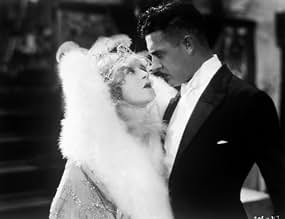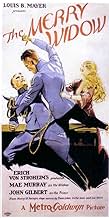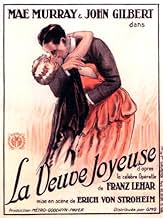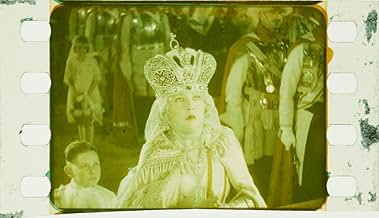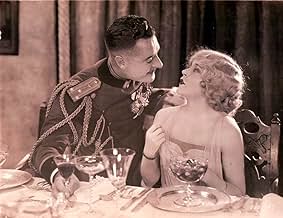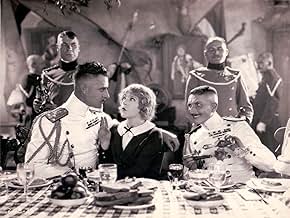VALUTAZIONE IMDb
7,2/10
2694
LA TUA VALUTAZIONE
Aggiungi una trama nella tua linguaA prince must woo the now-wealthy dancer he once abandoned, to keep her money in the country in order to keep it from crashing economically.A prince must woo the now-wealthy dancer he once abandoned, to keep her money in the country in order to keep it from crashing economically.A prince must woo the now-wealthy dancer he once abandoned, to keep her money in the country in order to keep it from crashing economically.
- Regia
- Sceneggiatura
- Star
- Premi
- 3 vittorie totali
Gertrude Bennett
- Hard-Boiled Virginia
- (non citato nei titoli originali)
Bernard Berger
- Boy
- (non citato nei titoli originali)
Sidney Bracey
- Danilo's Footman
- (non citato nei titoli originali)
Estelle Clark
- French Barber
- (non citato nei titoli originali)
Albert Conti
- Danilo's Adjutant
- (non citato nei titoli originali)
D'Arcy Corrigan
- Horatio
- (non citato nei titoli originali)
Joan Crawford
- Ballroom Dancer
- (non citato nei titoli originali)
Xavier Cugat
- Orchestra Leader
- (non citato nei titoli originali)
Anielka Elter
- Blindfolded Musician
- (non citato nei titoli originali)
Dale Fuller
- Sadoja's Chambermaid
- (non citato nei titoli originali)
Clark Gable
- Ballroom Dancer
- (non citato nei titoli originali)
Recensioni in evidenza
The Merry Widow was first seen by American audiences on Broadway during the 1907-08 season where it ran for 416 performances. For those of us who know it primarily from the sound films with first Maurice Chevalier and Jeanette MacDonald and later Fernando Lamas and Lana Turner, this version will be quite interesting. Let's just say that what was put in the talkies was a lot closer to the stage production. Erich Von Stroheim who directed this film added quite a bit to the story. In fact in the end it isn't quite so merry.
Most of the film is taken up with just how Mae Murray became The Merry Widow. She's an American dancer who is stranded in the remote Balkan kingdom of Monteblanco which is ruled by King George Fawcett. In line for the throne is the rakish Roy D'Arcy, a Snidely Whiplash villain if there ever was one. Behind him is his cousin John Gilbert playing Prince Danilo.
Murray comes to the attention of both men, Gilbert actually falls for her, D'Arcy would like an occasional roll in the hay, but marry her? There's a third guy out there in Tully Marshall who is the wealthiest man in the kingdom and it's principal banker. He leaves and the whole place goes into receivership. Marshall's an old dude with some alternative sexual interests that Von Stroheim exploits to the fullest on screen and he'd like a young trophy wife and Murray fills the bill.
She does become a wife ever so briefly and then of course the Merry Widow having had her fill of royalty. But now that she holds the Monteblanco purse strings, D'Arcy has taken a renewed interest in her and maybe she just might be a suitable queen.
I think you can see where this is going though Von Stroheim does tease us a bit with some possible alternatives before the film concludes. The audience of 1925 saw one lavish production that nearly broke the new Metro-Goldwyn studio. We only see about half the footage he shot if that.
One thing that Metro did not have to worry about was a soundtrack. The music of The Merry Widow was very familiar to the American public and it's played on the organ throughout the film. Young contract players Joan Crawford and Clark Gable are extras in the ballroom scene and good luck in spotting them. Although in the Citadel film series book on The Films Of Clark Gable there is a still from The Merry Widow where Gable is pointed out.
I'm sure John Gilbert little dreamed that in six years Gable would be supplanting him as the number one leading man at MGM. But in The Merry Widow he's a stalwart and resolute Danilo and Mae Murray actually does suggest a bit of what Jeanette MacDonald's performance would be in the first sound remake.
In the fate of what happens to D'Arcy's character, Von Stroheim opts for some realism in terms of the European scene of the past 25 years or so before the film debuted. In fact very little of the happy tone of The Merry Widow is preserved here. The film given how Murray got her millions ought to be retitled, The Trophy Widow.
Still it's an interesting alternative to the normal operetta productions we're used to seeing.
Most of the film is taken up with just how Mae Murray became The Merry Widow. She's an American dancer who is stranded in the remote Balkan kingdom of Monteblanco which is ruled by King George Fawcett. In line for the throne is the rakish Roy D'Arcy, a Snidely Whiplash villain if there ever was one. Behind him is his cousin John Gilbert playing Prince Danilo.
Murray comes to the attention of both men, Gilbert actually falls for her, D'Arcy would like an occasional roll in the hay, but marry her? There's a third guy out there in Tully Marshall who is the wealthiest man in the kingdom and it's principal banker. He leaves and the whole place goes into receivership. Marshall's an old dude with some alternative sexual interests that Von Stroheim exploits to the fullest on screen and he'd like a young trophy wife and Murray fills the bill.
She does become a wife ever so briefly and then of course the Merry Widow having had her fill of royalty. But now that she holds the Monteblanco purse strings, D'Arcy has taken a renewed interest in her and maybe she just might be a suitable queen.
I think you can see where this is going though Von Stroheim does tease us a bit with some possible alternatives before the film concludes. The audience of 1925 saw one lavish production that nearly broke the new Metro-Goldwyn studio. We only see about half the footage he shot if that.
One thing that Metro did not have to worry about was a soundtrack. The music of The Merry Widow was very familiar to the American public and it's played on the organ throughout the film. Young contract players Joan Crawford and Clark Gable are extras in the ballroom scene and good luck in spotting them. Although in the Citadel film series book on The Films Of Clark Gable there is a still from The Merry Widow where Gable is pointed out.
I'm sure John Gilbert little dreamed that in six years Gable would be supplanting him as the number one leading man at MGM. But in The Merry Widow he's a stalwart and resolute Danilo and Mae Murray actually does suggest a bit of what Jeanette MacDonald's performance would be in the first sound remake.
In the fate of what happens to D'Arcy's character, Von Stroheim opts for some realism in terms of the European scene of the past 25 years or so before the film debuted. In fact very little of the happy tone of The Merry Widow is preserved here. The film given how Murray got her millions ought to be retitled, The Trophy Widow.
Still it's an interesting alternative to the normal operetta productions we're used to seeing.
This is the kind of silent film that is so enjoyable to watch. Huge budget with a great cast. In the climatic dance sequence, where the "Merry Widow" dances, both Clark Gable and Myrna Loy, both unknowns at the time, were extras.
This is Cheshire, reporting from the 2004 Sydney Film Festival, where Erich von Stroheim's Merry Widow was just given a resounding hurrah! It was the darling of the festival! Never have i heard such hooping and cheering. Our enjoyment of the film was no doubt enhanced by the wonderful print and live piano, violin and brass accompaniment we were treated to.
I know Stroheim only went to Hollywood because he wanted to inject a bit of reality into the movies - and i think he did that superbly with Greed and those pictures before it. But the thing i loved most about Foolish Wives, for instance, my favourite Stroheim film so far (keeping in mind i'm yet to see Blind Husbands), was not how natural and real its performances were, though this was incredible, but Stroheim's wickedly subversive sense of humour. Foolish Wives is divine black comedy - and Merry Widow continues that tradition, not Stroheim's dream of realism. I can't believe Stroheim was depressed at how successful this film was, because he abandoned any attempts at "realism" to make it.
I think he achieves something better. I'm not one of these fellows who insists a picture hold a mirror up to reality to be good - if i was interested in reality, i'd watch a documentary, or perhaps sit on a park bench and watch the thing itself! I go to the pictures to see a different world, with a reality all its own. Its why i love the work of Fellini, the Coen Brothers, David Lynch, Wes Anderson, Kubrick and Co. They give us something better than reality! I think that's what Stroheim does here, and despite the fact that he didn't respect what he did, I think its among his greatest achievements. For modern audiences, The Merry Widow is one of the most delightful pieces of black salacious comedy available before the last twenty years (along with Bunuel's priceless L'Age D'Or). Such intelligent, aware humour - we all had a great laugh at the State Theatre in Sydney.
John Gilbert looks marvelous on screen, and MY what a fantastic actor he was. But the show is all but stolen by Roy D'Arcy, as Stroheim's beloved evil cousin figure. His salacious grin is a thing to behold. He cracked the audience up throughout. Seems D'Arcy is a great unsung hero of the cinema, from looking at his credits list. Perhaps a rediscovery of La Boheme and Bardleys the Magnificent might rejuvenate his memory, not to mention a beautiful DVD edition of The Merry Widow... or even a VHS edition! Who are we kidding here, guys! This is not only one of the most enjoyable silent films i've ever seen, its just a darn tootin' good comedy!
For all the talk of the "boundless shots of shoes" i'd heard were in this movie, i was expecting it to be a two-hour long shoe-store commercial. Whoever went on like that about this movie, including Irving Thalberg, must SO not have even heard of foot fettishism. Its so obvious when you see the picture. There are probably six shots of shoes in the picture total (!), and four of them are to illustrate one of the B-characters as a foot fetishist, which is fairly obvious, since he licks his lips and virtually salivates when he looks at feet! This is also ironic for this character, because his feet are the location of his disability: he walks with comic difficulty on two replacement feet, crutches. The remaining shoe shots are part of a delightful scene involving a game of footsies, which i won't spoil for you, but they are most certainly justified by the narrative.
Look, this is the sort of film i'd love to have on a pretty DVD edition (attention Kino!) as part of the wonderful Erich von Stroheim Collection sitting next to my bed so i can watch it to send me off onto a nice sleep. Its the most fun of Stroheim's films, but he in no way sells out, in my opinion. The humour is satirical, subversive "let's see what i can get away with" comedy - a treat!
For the record, i recommend to you in this order:
1. Foolish Wives 2. The Merry Widow (when its released some time soon, or at a film festival near you) 3. Greed 4. The Wedding March 5. Queen Kelly
(the only other surviving Stroheim picture i'm yet to see is Blind Husbands, and he only directed some scenes from Merry-Go-Round, which you can see on the doco The Man You Love to Hate - they're pretty great!)
I know Stroheim only went to Hollywood because he wanted to inject a bit of reality into the movies - and i think he did that superbly with Greed and those pictures before it. But the thing i loved most about Foolish Wives, for instance, my favourite Stroheim film so far (keeping in mind i'm yet to see Blind Husbands), was not how natural and real its performances were, though this was incredible, but Stroheim's wickedly subversive sense of humour. Foolish Wives is divine black comedy - and Merry Widow continues that tradition, not Stroheim's dream of realism. I can't believe Stroheim was depressed at how successful this film was, because he abandoned any attempts at "realism" to make it.
I think he achieves something better. I'm not one of these fellows who insists a picture hold a mirror up to reality to be good - if i was interested in reality, i'd watch a documentary, or perhaps sit on a park bench and watch the thing itself! I go to the pictures to see a different world, with a reality all its own. Its why i love the work of Fellini, the Coen Brothers, David Lynch, Wes Anderson, Kubrick and Co. They give us something better than reality! I think that's what Stroheim does here, and despite the fact that he didn't respect what he did, I think its among his greatest achievements. For modern audiences, The Merry Widow is one of the most delightful pieces of black salacious comedy available before the last twenty years (along with Bunuel's priceless L'Age D'Or). Such intelligent, aware humour - we all had a great laugh at the State Theatre in Sydney.
John Gilbert looks marvelous on screen, and MY what a fantastic actor he was. But the show is all but stolen by Roy D'Arcy, as Stroheim's beloved evil cousin figure. His salacious grin is a thing to behold. He cracked the audience up throughout. Seems D'Arcy is a great unsung hero of the cinema, from looking at his credits list. Perhaps a rediscovery of La Boheme and Bardleys the Magnificent might rejuvenate his memory, not to mention a beautiful DVD edition of The Merry Widow... or even a VHS edition! Who are we kidding here, guys! This is not only one of the most enjoyable silent films i've ever seen, its just a darn tootin' good comedy!
For all the talk of the "boundless shots of shoes" i'd heard were in this movie, i was expecting it to be a two-hour long shoe-store commercial. Whoever went on like that about this movie, including Irving Thalberg, must SO not have even heard of foot fettishism. Its so obvious when you see the picture. There are probably six shots of shoes in the picture total (!), and four of them are to illustrate one of the B-characters as a foot fetishist, which is fairly obvious, since he licks his lips and virtually salivates when he looks at feet! This is also ironic for this character, because his feet are the location of his disability: he walks with comic difficulty on two replacement feet, crutches. The remaining shoe shots are part of a delightful scene involving a game of footsies, which i won't spoil for you, but they are most certainly justified by the narrative.
Look, this is the sort of film i'd love to have on a pretty DVD edition (attention Kino!) as part of the wonderful Erich von Stroheim Collection sitting next to my bed so i can watch it to send me off onto a nice sleep. Its the most fun of Stroheim's films, but he in no way sells out, in my opinion. The humour is satirical, subversive "let's see what i can get away with" comedy - a treat!
For the record, i recommend to you in this order:
1. Foolish Wives 2. The Merry Widow (when its released some time soon, or at a film festival near you) 3. Greed 4. The Wedding March 5. Queen Kelly
(the only other surviving Stroheim picture i'm yet to see is Blind Husbands, and he only directed some scenes from Merry-Go-Round, which you can see on the doco The Man You Love to Hate - they're pretty great!)
Merry Widow, The (1925)
*** (out of 4)
Big-budget version of the classic stage production marked the final time MGM would work with director von Stroheim who was hired on for what was suppose to be a short film but he would take it and mold it into a 137-minute epic of sorts. The story is pretty well known but it centers on an American dancer (Mae Murray) who gets stranded in a small town where she meets a Prince (John Gilbert) who quickly falls for her. The two have many troubles throughout their relationship including the King (George Fawcett) objecting. According to legend, MGM offered von Stroheim a $10,000 bonus if he could shoot this movie in a three week period. Each week he was over that the bonus would be sliced by $2,000. Needless to say, it ended up taking four months to shoot and MGM pocketed any bonus money that was to be given out. Apparently this film nearly brought the studio down but it turned out being a hit and the rest is history. von Stroheim certainly has a very sinister look and atmosphere running throughout the film and this is something I'm not sure would be in future versions. Since this is the first version I've seen I really can't compare it to anything but I'm sure fans of the director or silent film buffs will really eat this film up even if it isn't the masterpiece one would hope for considering the talent involved. The highlight is clearly the visual look of the film, which is quite stunning from the opening shot to the final one. There are all sorts of strange camera set ups including my favorite that happens around the fifty-minute mark as Murray and Gilbert are having dinner and the director keeps the camera in a long shot with the two actors sitting at the very right of the screen, nearly off camera. This is such a strange shot that it can't help but grab your attention and make you take notice. There are countless other great trick shots throughout the film and von Stroheim certainly builds a wonderful atmosphere that is quite thick and at times haunting. The performances by the two leads are very good as well with both playing off one another wonderfully. I thought the romantic aspect of the story was fully believable as both actors perfectly nail the more dramatic parts and Gilbert getting a special notice for some nice comic timing. If I had any problem with the film its the running time as I felt there could have been some trims here and there and nothing would have been lost on the story. Apparently Clark Gable and Joan Crawford are extras in the mammoth ballroom sequence but I was unable to spot them.
*** (out of 4)
Big-budget version of the classic stage production marked the final time MGM would work with director von Stroheim who was hired on for what was suppose to be a short film but he would take it and mold it into a 137-minute epic of sorts. The story is pretty well known but it centers on an American dancer (Mae Murray) who gets stranded in a small town where she meets a Prince (John Gilbert) who quickly falls for her. The two have many troubles throughout their relationship including the King (George Fawcett) objecting. According to legend, MGM offered von Stroheim a $10,000 bonus if he could shoot this movie in a three week period. Each week he was over that the bonus would be sliced by $2,000. Needless to say, it ended up taking four months to shoot and MGM pocketed any bonus money that was to be given out. Apparently this film nearly brought the studio down but it turned out being a hit and the rest is history. von Stroheim certainly has a very sinister look and atmosphere running throughout the film and this is something I'm not sure would be in future versions. Since this is the first version I've seen I really can't compare it to anything but I'm sure fans of the director or silent film buffs will really eat this film up even if it isn't the masterpiece one would hope for considering the talent involved. The highlight is clearly the visual look of the film, which is quite stunning from the opening shot to the final one. There are all sorts of strange camera set ups including my favorite that happens around the fifty-minute mark as Murray and Gilbert are having dinner and the director keeps the camera in a long shot with the two actors sitting at the very right of the screen, nearly off camera. This is such a strange shot that it can't help but grab your attention and make you take notice. There are countless other great trick shots throughout the film and von Stroheim certainly builds a wonderful atmosphere that is quite thick and at times haunting. The performances by the two leads are very good as well with both playing off one another wonderfully. I thought the romantic aspect of the story was fully believable as both actors perfectly nail the more dramatic parts and Gilbert getting a special notice for some nice comic timing. If I had any problem with the film its the running time as I felt there could have been some trims here and there and nothing would have been lost on the story. Apparently Clark Gable and Joan Crawford are extras in the mammoth ballroom sequence but I was unable to spot them.
Stroheim's take on the familiar story is filled with his customary pomp and spectacle while never losing sight of the love story at its core. It's something of a slog at over two hours long though, and Gilbert's royal prince comes across as something of a sleaze at times. However, Roy D'Arcy makes a wonderfully hissable villain as the scheming Crown Prince Mirko (a role von Stroheim originally ear-marked for himself).
Lo sapevi?
- QuizWhile filming the climactic ballroom scene, Erich von Stroheim noticed an extra whose costume was not adjusted to his liking. He stepped off the high camera platform on which he was standing, fell, and broke his leg. He directed the rest of the film from a reclining chair while his leg healed.
- BlooperA title card reads "a prince has a duty to his country higher then [sic] his duty to himself" - a grammatical error unusual for such a prestigious studio as MGM.
- Citazioni
Prince Danilo Petrovich: Where the devil did you get these pictures?
Danilo's Adjutant: From my barber--he said he got them in Paris.
- Curiosità sui creditiThe credits state that the film is "personally directed by" Erich von Stroheim.
- Versioni alternativeThe version shown on the Turner Classic Movies (TCM) channel has the musical score arranged by Dennis James and performed by him on a Möller pipe organ. It is shown at a proper silent movie speed and runs 137 minutes.
- ConnessioniEdited into Histoire(s) du cinéma: Seul le cinéma (1994)
I più visti
Accedi per valutare e creare un elenco di titoli salvati per ottenere consigli personalizzati
- How long is The Merry Widow?Powered by Alexa
Dettagli
- Data di uscita
- Paese di origine
- Lingua
- Celebre anche come
- The Merry Widow
- Luoghi delle riprese
- Aziende produttrici
- Vedi altri crediti dell’azienda su IMDbPro
Botteghino
- Budget
- 592.000 USD (previsto)
- Tempo di esecuzione2 ore 17 minuti
- Colore
- Mix di suoni
- Proporzioni
- 1.33 : 1
Contribuisci a questa pagina
Suggerisci una modifica o aggiungi i contenuti mancanti

Divario superiore
By what name was La vedova allegra (1925) officially released in India in English?
Rispondi
